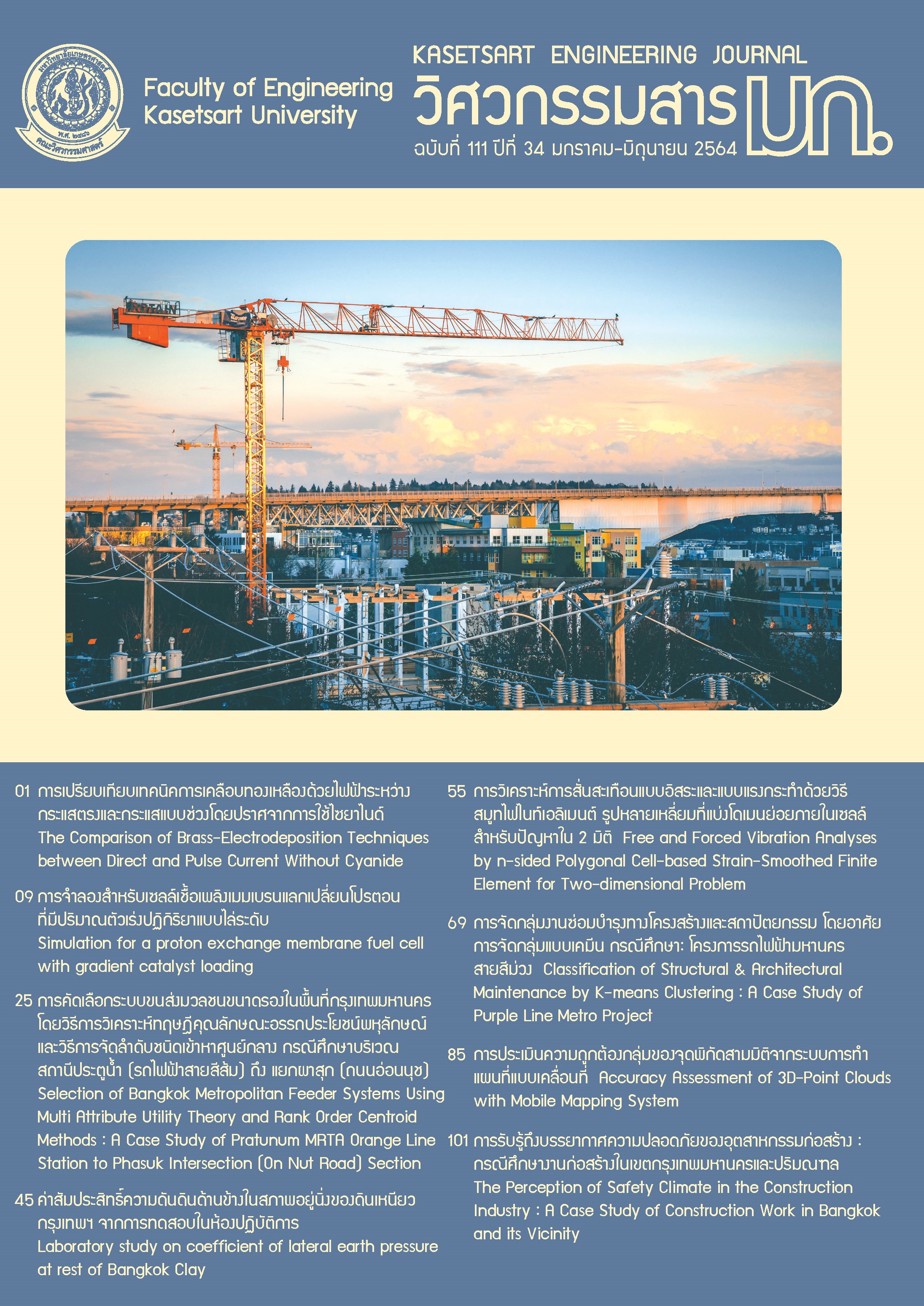Free and Forced Vibration Analyses by n-sided Polygonal Cell-based Strain-Smoothed Finite Element for Two-dimensional Problem
Keywords:
n-sided Polygonal element, Smoothed finite element, Cook’s beam, Free vibration, Periodic vibrationAbstract
Free and forced vibration analyses using n-sided polygonal element-based strain-smoothed finite element for two-dimensional problem is investigated for this research. Initialized with triangular elements discretization on problem domain like an old fashion finite element, an arbitrary n-sided polygon elements can be created by Delaunay triangulation algorithms for unstructured triangular mesh. Those polygonal elements will then be further partitioned into quadrilateral smoothing cells. A modified Cook beam with three holes which its left side is hinged while the opposite side is imposed to shear traction in vertical direction is an example for numerical simulation. Two types of analyses are performed namely free and transient vibration. Due to unavailable exact solutions, close-to-exact solutions obtained from very fine quadrilateral meshes finite element analysis are utilized instead. The former analysis investigates the first four natural frequencies and corresponding mode shapes of an example beam by soling an Eigenvalue problem. The results show in good agreement between polygonal smoothed finite element and reference solutions. The latter is forced periodic vibration analysis using implicit Newmark-Beta method comparing a vertical displacement at a particular point in specified duration of force dependent triangular time variation. The results are also in good shape with reference solutions at all periods of analysis time with few numbers of polygonal elements compared to a traditional one.
References
Beirão da Veiga, L, Brezzi, Franco, Marini, Luisa Donatella, Russo, Alessandro (2014). The hitchhiker's guide to the virtual element method. Journal of Mathematical models, & sciences, methods in applied, 24(08): 1541-1573.
Wolf, John P (2003). The scaled boundary finite element method: John Wiley & Sons.
Liu Gui-Rong and Trung Nguyen. (2016). Smoothed finite element methods: CRC press.
Liu GR, Zhang GY, Dai KY, Wang YY, Zhong ZH, Li GY, Han X (2015). A linearly conforming point interpolation method (LC-PIM) for 2D solid mechanics problems. International Journal of Computational Methods, 2(04): 645-665.
Liu Gui-Rong (2019). The smoothed finite element method (S-FEM): A framework for the design of numerical models for desired solutions. Frontiers of Structural, & Engineering, Civil, 13(2): 456-477.
Liu GR, Nguyen TT, Dai KY, Lam KY (2007). Theoretical aspects of the smoothed finite element method (SFEM). International journal for numerical methods in Engineering, 71(8): 902-930.
He ZC, Li GY, Zhong ZH, Cheng AG, Zhang GY, Liu GR, Zhou Z (2013). An edge-based smoothed tetrahedron finite element method (ES-T-FEM) for 3D static and dynamic problems. Computational mechanics, 52(1): 221-236.
Nguyen-Thoi, T Bui-Xuan T, Liu GR, Vo-Duy, T (2018). Static and free vibration analysis of stiffened flat shells by a cell-based smoothed discrete shear gap method (CS-FEM-DSG3) using three-node triangular elements. International Journal of Computational Methods, 15(06): 1850056.
Jiang Chen, Zhang Zhi‐Qian, Han Xu, Liu Gui‐Rong (2014). Selective smoothed finite element methods for extremely large deformation of anisotropic incompressible bio‐tissues. International Journal for Numerical Methods in Engineering, 99(8): 587-610.
Rong Xin, Niu Ruiping, Liu Gui Rong (2020). Stability analysis of smoothed finite element methods with explicit method for transient heat transfer problems. International Journal of Computational Methods, 17(02): 1845005.
Bhowmick Sauradeep, and Liu GR (2018). On singular ES-FEM for fracture analysis of solids with singular stress fields of arbitrary order. Engineering Analysis with Boundary Elements, 86: 64-81.
Liu Jun, Zhang Zhi-Qian, Zhang Guirong (2015). A smoothed finite element method (S-FEM) for large-deformation elastoplastic analysis. International Journal of Computational Methods, 12(04): 1540011.
Persson Per-Olof, and Strang, Gilbert (2004). A simple mesh generator in MATLAB. SIAM review, 46(2): 329-345.
Talischi Cameron, Paulino Glaucio H Pereira, Anderson Menezes, Ivan FM (2012). PolyMesher: a general-purpose mesh generator for polygonal elements written in Matlab. Structural, Optimization, and Multidisciplinary, 45(3): 309-328.
Timoshenko Stephen P and Gere James M. (2009). Theory of elastic stability: Courier Corporation.
Ooi Ean Tat, Song Chongmin, Tin‐Loi Francis, Yang Zhenjun (2012). Polygon scaled boundary finite elements for crack propagation modelling. International journal for numerical methods in engineering, 91(3): 319-342.
Bathe Klaus-Jürgen and Wilson, Edward L (1976). Numerical methods in finite element analysis: Prentice Hall.
Hilber Hans M, Hughes Thomas JR, Taylor Robert L (1977). Improved numerical dissipation for time integration algorithms in structural dynamics. Earthquake Engineering, & Dynamics, Structural, 5(3): 283-292.
Biggs John M and Biggs, JM (1964). Introduction to structural dynamics. ISBN 07-005255-7.
Newmark Nathan M (1962). A method of computation for structural dynamics. Transactions of the American Society of Civil Engineers, 127(1): 1406-1433.
Downloads
Published
Issue
Section
License

This work is licensed under a Creative Commons Attribution-NonCommercial-NoDerivatives 4.0 International License.


